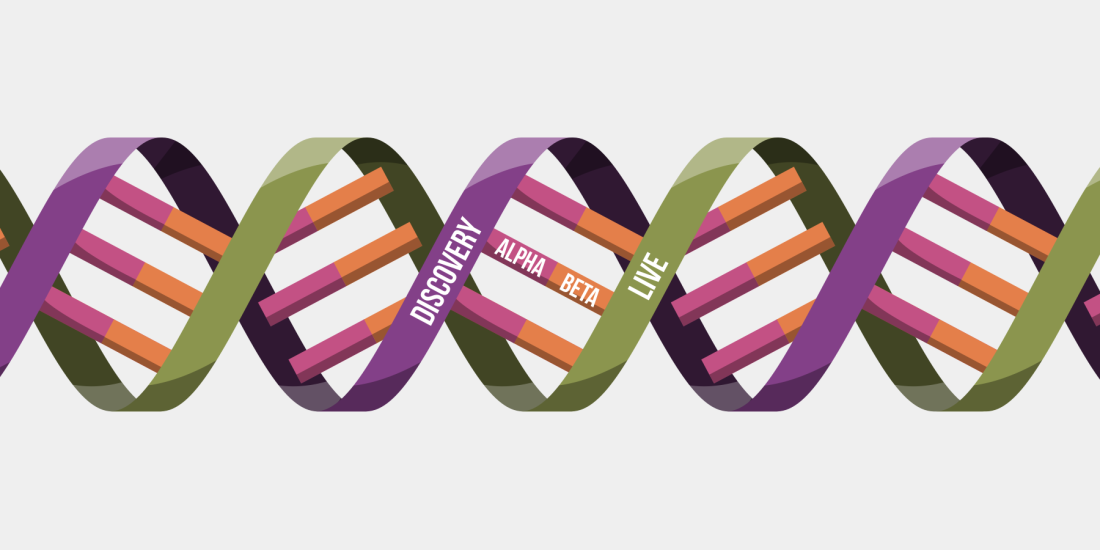Some of the organisations I work with are just starting out on this digital transformation thing. More and more of them, however, have been at it for quite some time. After 2, 3, even 4 years, a delivery process of discovery, alpha and beta is well embedded, in parts of the organisation at least.
Now I’m seeing more of the next struggle. I think it feels hard because, while alpha and beta can be treated as phases of service development, being live affects the whole organisation. This post is a first go at answering an existential challenge for digital specialists: what does it mean to go live?
1. It’s… alive!
No metaphor is wholly adequate. But it’s fair to say that accounts of organisational life have shifted over the last decades from the mechanical analogies of Taylorism to natural and biological ones. There’s less talk of levers and gears, more of evolution and growth.
What these analogies capture, and the machine-age ones miss, is the sense of aliveness. “Going live”, like Frankenstein’s monster, means crossing a threshold from being a well-assembled collection of parts to a sensing, thinking, adapting being in its environment.
There’s a quiet focus that comes from seeing serious numbers of people accessing your service right now. Digital teams make user activity visible. They fight hard to stay together for their service after crossing into live.
As Kit Collingwood-Richardson puts it, going live is like having a baby, with a whole future of parenting stretching ahead. “Go live is the start”.
2. Time in reverse
In big organisations, agile development teams and service operations teams can sometimes feel like they’re on different planets. But I reckon they have something important in common: a healthy focus on the here-and-now. As Mat Wall says, agile is basically: “What do you want by Friday? And how can we make it better than last week?” Both those questions would be familiar in any high-performing front line service team. In a live organisation this common focus for development and operations becomes a powerful unity of purpose.
Agile development and operations both occupy what the sociologist Anthony Giddens describes as the temporal existence of “durée” – performing routinely, but with the possibility of change in every repetition. To Giddens, this is only the first of three sorts of time:
- durée of day-to-day experience
- life span of the individual
- longue durée of institutions
The middle layer – the life span of the individual – is “irreversible time”. Its arrow goes in only one direction, and I have the grey hairs to prove it. This is where we find dedicated change management, the top-left to bottom-right sweep of the Gantt chart.
In contrast, the day-to-day and institutional time – a commitment stretching out indefinitely – are “reversible”. They always have the possibility to do over, to do differently, to do better.
To go live is to adopt a different attitude to time. We’re no longer burning down towards a deadline. We have embraced changefulness as a daily habit, supported by a long-term structure. We are committed to be here every day, as long as it takes, as long as there are people to be served. Any service that lacks this habit and structure isn’t live, it’s dead already.
3. Discovery is a culture, not a phase

Despite the recycling symbols, the service lifecycle drawn left-to-right can look a bit, well, waterfall-y. Discovery leads to alpha, as alpha leads to beta, and beta leads to live in resolutely irreversible time.
In particular, the distance between discovery and live seems to me wholly misleading. After all, live, running service affords all sorts of discovery possibilities that wouldn’t otherwise exist.
I know I’m not the only one who has tried redrawing this picture. I’ve tried drawing it as a stacked bar chart, as a circle, as a Möbius strip, and I’ve ended up with this…

In a sufficiently advanced organisation, discovery is a culture, not a phase. Intertwined live service and discovery continually fulfil and refine the purpose of the organisation.
- Curious about something that’s showing up in the web analytics? Go and do some user research!
- Hearing something new from customers in research? Go and see for yourself what is happening on the front line!
The odd ones out in this picture are alphas and beta – the phases where early-stage digital transformation organisations probably spend most of their time and attention.
Don’t think of (capital “D”) Discovery as something we do to prepare for the (definite article) Alpha Phase, think of an alpha version as one potential response to a new discovery. Alphas and betas are just tactical things we can make to bridge discoveries back into live service.
4. The strategy is (continuous) delivery
The discovery|live duality respects no boundaries between strategy, “change” and operations. Instead of clumsily executing planned but discontinuous change, the live organisation is always sensing and responding, making work visible, and reflecting frequently on how to do better.
Going live demands, in the words of David Marquet, that we move the authority to where the information is:
- Policy advisors, strategists and designers can accomplish their work more effectively and at greater pace because they have very frequent contact with the realities of everyday service delivery
- Everyone who delivers service has the power to make better decisions, multiple times per day; they must be trusted to take decisions that are aligned to the organisation’s purpose and priorities
- Process changes are no longer pushed to workers on the front line; instead they frequently pull in change based on the demands they experience in contact with customers
- Colleagues, suppliers and customers work together in a spirit of productive informality
- Everyone becomes – to a greater or lesser degree – a service designer.
This is what I meant when I said learning by doing was the last target operating model you’d ever need.
5. All users become co-creators
Going live is often seen as only affecting the people inside an organisation. After all, users shouldn’t have to care what labels we use internally. Nevertheless, it should feel different to be a user of a live organisation.
Sure, your digital team may be highly user-centric already. You frequently engage users in defined, intentional activities – research visits, usability studies, private beta versions and so on. But to the majority of users, big organisations still appear unfeeling, inert and unresponsive.
When service is genuinely live, every interaction with users is an opportunity for new learning. Because the organisation is alive, it can sense people’s needs and adapt itself to meet them. Users become everyday co-creators of service. They learn to be more demanding, and to expect frequent change.
That’s when the fun really starts: when users realise that service can adapt to fit them. They begin to bring more than just their needs. They bring their unique capabilities to be combined with emergent competencies of the organisation. The “so that” line in the user story template comes into its own. We lift our sights from a deficit-based view of user needs to an asset-based vision of human potential. In live service, customer relationships are an endless source of ideas and innovation.
6. The new high score
Arbitrary double standards between capital and operational spending can easily bend organisational priorities out of shape. Agile abhors upfront spending divorced in time from actual customer value. Yet this is precisely what common accounting conventions reward. We need to change the high score.
Ironically the knowledge organisation’s most valuable assets are often its least visible. The conscious competence learning model presents “unconscious competence” as the apex of a pyramid of skill. Having begun in blissful ignorance, learners first become conscious of their own incompetence. They must go through a stage of consciously improving their competence until it comes so naturally that they can do it without noticing. But if we don’t notice the stuff we’re best at, there’s a risk we’ll undervalue it.
So the live organisation needs a new kind of balance sheet, one that deprecates unnecessary inventory and investments. Instead it recognises its most valuable asset: the growing skills, knowledge, networks and confidence of customers, workers and suppliers alike.
Live is when real digital transformation begins. It marks a radically different way of managing everyday work, and a new culture of continuous discovery. It will flatten decision-making structures, and transform passive users into active co-creators. The ways we measure and account for success will be different. But the potential payoffs are huge.
Go live. I dare you.

I really like your DNA disco diagram – it is a big improvement on the standard view. There is still one thing implied though that I find quite insidious: not all discoveries should lead to a live release. What if you do the discovery to test the idea you had, and discover it was illusory and not worth acting on, or that it was actually a terrible idea and the user research indicated it would only make things worse? I have the same problem at the alpha ‘stage’ – how often do teams think that to not take a ‘prototype’ into beta is a sign of failure? I’ve seen perfectly good *prototypes* that proved the way everyone _thought_ a project should go was plain wrong and needed a different approach be swept under the carpet – rather than be celebrated and learnt from by the wider organisation. I guess I am arguing that those diagrams need dead-ends.
Thanks Matt, I like the idea about dead ends. Maybe there’s a drawing of this that branches out like a tree. The path we choose for a service is only one – and maybe not even the best – possible future.